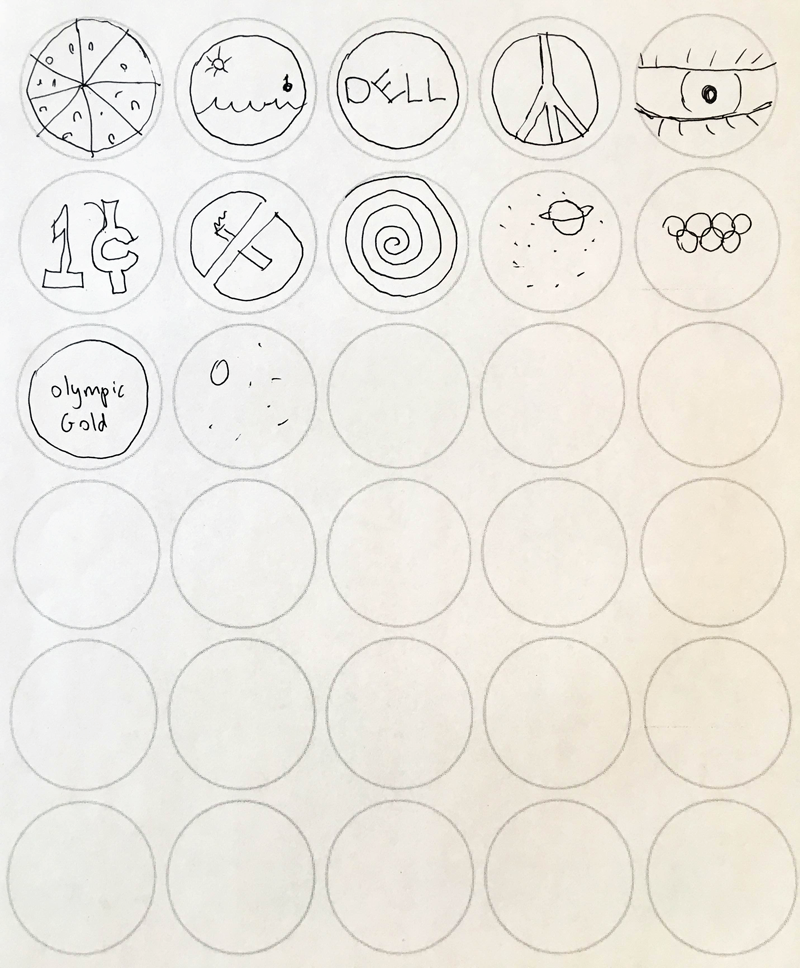
When we were young, creative play came easily.
A cardboard box became a rocket ship or part of a robot costume as you battled your siblings in the yard. Children are used to looking at objects for what they can be, instead of what they are at face value. As adults, as we experience more criticism and feedback, we become less open to playful and creative thinking. We get embarrassed more easily at our ideas. And, in turn, we lose our creative freedom.
As artists, however, we rely on our creativity to keep us pushing forward and feeling satisfied with our work.
Luckily, just like any skill, we can train our creativity and strengthen it through exercises.
We put together a few creativity exercises to get your imagination activated. Then, we challenged our co-founders, John Feustel and Justin Anthony to complete them. Let's see how they did.
Complete the Incomplete Figure Test
A classic test of creativity, the Torrance Test of Creative Thinking was introduced by psychologist Ellis Paul Torrance in the sixties as a way to administer a more creatively inclined IQ test. Respondents were given images like the ones below and asked to finish the picture. Higher points were awarded for answers that included rich imagery, implied narrative, or used humor or fantasy.

But the thing is: you don’t have to be part of a research group to gain the benefits of this thought experiment. We put Justin and John to the test in a battle of the creative wits and here is what they came up with (in two minutes). Here are the final results!


Pictured on the far right is the "wacky wavy inflatable balloon man" in front of a T-Mobile store. All points awarded to John.
Complete the Picture
This quick exercise dubbed “The Doodle Dandy,” was found on How Design, and is similar to the Incomplete Figure Test, but has room for more variations. It’s basically the same principle as the first exercise, except you get a stack of simple one-line scribbles and a stack of short phrases and you must create the phrase from one of the doodles.
Here is their sample phrase list, though they also encourage you to come up with your own.
"Happy as a clam"
"I can’t get no satisfaction"
"Where in the world?"
"A hard day’s night"
"Human nature"
"The art of noise"
and "Here comes trouble"
We gave Justin and John the phrase, “ Here Comes Trouble” and this doodle. Considering the whole point of the exercise is not to create a masterpiece … we think they did pretty well.


For some reason, both Justin and John went straight to Dragons for this one. Probably time to limit the Game of Thrones.
Look Away from What You Are Creating
We tried out this direct observation technique from marketing and creative coach Mark McGuinness. The goal of the exercise is to work on drawing what you really see, instead of what you think you see.
Here is the gist: grab a pencil, some paper and give yourself five minutes. However, instead of looking at the page while you are drawing, turn around, hold up your hand and look only at your hand while drawing, NOT the paper.
Your aim is to draw the creases, folds, and marks of your hand and not your entire hand. Oh, and you also can’t pick up your pencil for the entire five minutes.
Even though it was a challenge not to peek the entire time, and everyone felt a little silly, it was a great exercise to loosen up and focus on process and seeing, instead of simply end results.


If you imagine the illustration on the left as a left hand with the palm up ... that's pretty good!
Turn Your World Upside-Down
One way to shake things up is to literally turn your world (or drawing) upside-down, suggests Lori McNee of Fine Art Tips.
Lori tasks you with finding a picture of a person’s face, turning it upside-down, and then drawing it that way. She says to “forget that you are drawing a human face; instead concentrate on the shapes, lines, angles, and patches of light and dark.”
Based on concepts from Betty Edward’s book Drawing on the Right Side of the Brain, this exercise is used to strip us of our conditioned perspective to look for recognizable features that make up the face. Instead of seeing, “oh this is where the nose is supposed to go, this is the place for the eyes,” we begin to see the face for how it actually, and can begin to draw more realistically.
We didn’t try this one, but if you give it a shot, post your photo in the comments!
Concentrate on Quantity
We recently wrote about Tim Brown’s amazing 2008 TEDTalk Tales of Creativity in Play in which he talks about this next exercise. Created by Bob McKim of the Stanford Design Program, the 30 circles exercise is simple in practice and quick to complete.
Each participant is given a piece of paper with 30 blank circles on it, a pencil and 3 minutes on the clock. You are challenged to fill in as many circles as possible- with the aim being quantity, not quality. Maybe all your circles are variations on a theme, perhaps they are all emojis … your one goal was to fill out as many as possible.
Then, after the exercise, share and reflect what similarities there were and encourage collaboration. The motive behind the 30 circles is to stop yourself from self-censoring. When you go for quantity, you don’t have time to think your idea is bad, you can edit later. This is the stage where creativity flourishes.


This one is interesting because we are really asking for quantity. Justin crushed it with a clock type theme, while John channeled the Olympics.
Make Treasure out of Trash
John Ingledew’s latest book, How to Have Great Ideas: A Guide to Creative Thinking, has a collection of over 50 strategies to get creatives back to being creative. FastCo Design picked out their favorites, and among the top, was this brilliant and hilarious exercise where you take all your junk mail and use it as your project materials.
As adults, we see objects for their intended purpose. We are past seeing the cardboard box like a rocket ship, but what if all those credit card offers, coupons, and junk mail could become something other than junk mail. What if instead of sitting there in a pile to be recycled, you asked, “What else can I do with this?"
Alternative Uses
Prior to Ingledew’s junk mail project, there were other alternative use of creativity exercises. In 1967 J.P. Guilford developed the test that gave participants two minutes to think of as many possible uses for a common object. It’s commonly referred to at the “paper-clip test.” While participants don’t actually have to construct different uses, some ideas are weighted more heavily than others.
Respondents are ranked according to the four categories in divergent thinking: fluency (how many you named), originality (how common the answers are), flexibility (how many unique subjects you cross), and elaboration (level of detailed response).
Here are some fun ones our team came up within two minutes: a zipper replacement, a heart-shaped earring, an ear-piercing device, a phone stand, a lock pick, a ring, a fish hook, a photo holder, a tool to reset the router, an "aggressive toothpick," a "thing to poke John with," nail cleaner, rubber band ammo, and a hairpin.
Try this one for yourself and let us know what you come up with. You have two minutes. Ready, set, go!



![[GUIDE] The Best Artist Grants & Opportunities in December 2025](https://d1zdxptf8tk3f9.cloudfront.net/articles/2037/large/Ngoc-Tran_Vu_-_December_Opp_Guide_Image_%281%29.png?1763424558)


